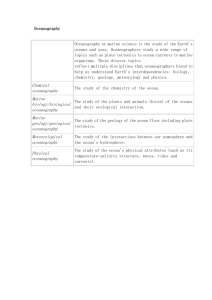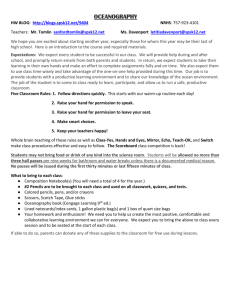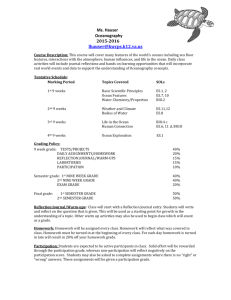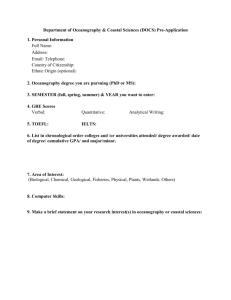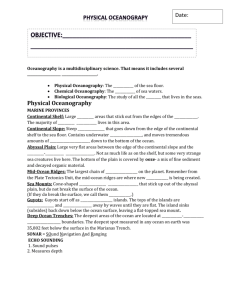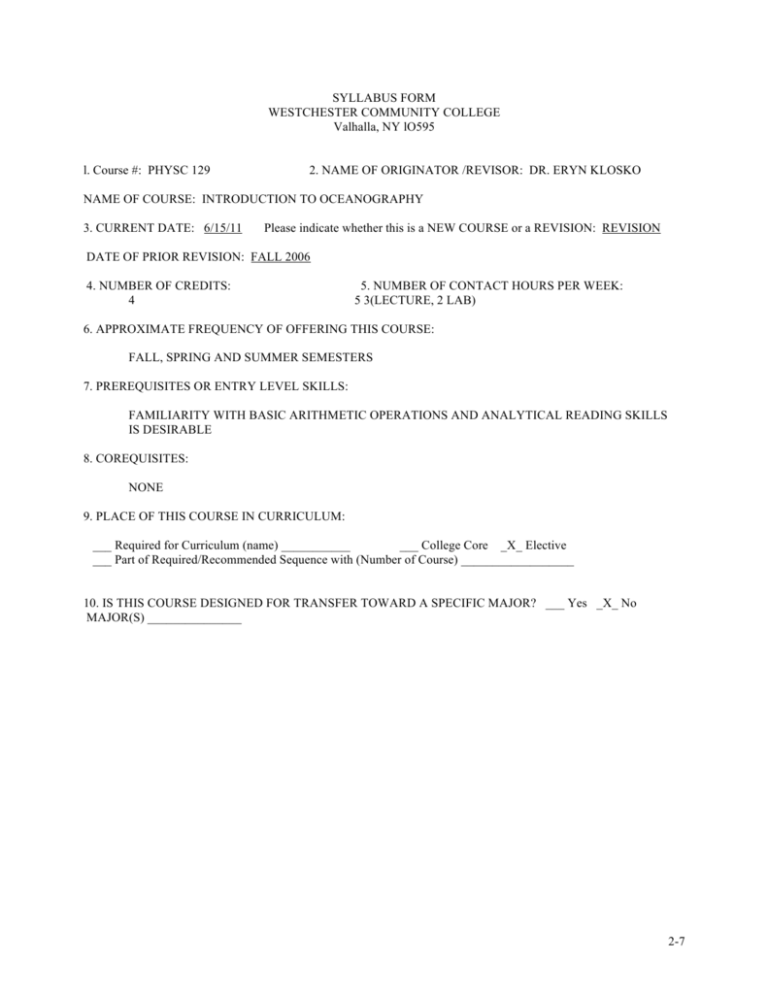
SYLLABUS FORM
WESTCHESTER COMMUNITY COLLEGE
Valhalla, NY lO595
l. Course #: PHYSC 129
2. NAME OF ORIGINATOR /REVISOR: DR. ERYN KLOSKO
NAME OF COURSE: INTRODUCTION TO OCEANOGRAPHY
3. CURRENT DATE: 6/15/11
Please indicate whether this is a NEW COURSE or a REVISION: REVISION
DATE OF PRIOR REVISION: FALL 2006
4. NUMBER OF CREDITS:
4
5. NUMBER OF CONTACT HOURS PER WEEK:
5 3(LECTURE, 2 LAB)
6. APPROXIMATE FREQUENCY OF OFFERING THIS COURSE:
FALL, SPRING AND SUMMER SEMESTERS
7. PREREQUISITES OR ENTRY LEVEL SKILLS:
FAMILIARITY WITH BASIC ARITHMETIC OPERATIONS AND ANALYTICAL READING SKILLS
IS DESIRABLE
8. COREQUISITES:
NONE
9. PLACE OF THIS COURSE IN CURRICULUM:
___ Required for Curriculum (name) ___________
___ College Core _X_ Elective
___ Part of Required/Recommended Sequence with (Number of Course) __________________
10. IS THIS COURSE DESIGNED FOR TRANSFER TOWARD A SPECIFIC MAJOR? ___ Yes _X_ No
MAJOR(S) _______________
2-7
11. COURSE OUTCOMES:
List the course’s learning outcomes and describe how each outcome will be measured.
Outcome - Upon successful completion, the student will
be able to:
1. Students will be able to evaluate and analyze current
newspaper, magazine and other media articles that relate
to Oceanography in terms of the relationship between
biological, physical and chemical sciences and
economics, politics, society, and past modern cultures.
2. Students will be able to interpret and analyze
connections between Earth phenomena and the oceans
(such as the link between atmospheric circulation and
oceanic surface currents).
3. Students will understand and perform basic scientific
data gathering techniques in physics, chemistry, geology,
biology and geography that are used to study the oceans.
4. Students will understand and be able to explain cyclic
changes in the natural world from specific elemental
cycles (The Carbon Cycle) through large scale natural
processes (climate change).
5. Students will be able to explain the origin,
composition, and dynamics of the world ocean, including
density, salinity, temperature, currents, tides, waves and
common classifications of life in the seas.
6. Students will understand the history of Oceanography
and how it became an area of scientific inquiry.
This outcome will be measured by one or more of the
following:
1. Homework, assignments, class activities
2. Class examinations, final exam, lab reports
Homework and class activities
3 Lab reports
4. Class examinations, final exam, lab reports
Homework and class activities
5. Class examinations, final exam, lab reports
Homework and class activities
6. Class examinations, final exam, lab reports, homework
assignments and class
12. COURSE GRADE
Based on the above measures, how will the final course grade be calculated?
Homework Assignments
14 One-page essays (analytical) and homework activities
10%
Lab Work
8 Laboratory experiments/explorations with reports and two exams
25%
Class Examinations
3 exams to assess student’s achievement
40%
Final Exam
Comprehensive exam
25%
Make-up Policy:
a) No make-up exams without prior arrangement (very special circumstances excluded)
b) 10% per day lateness penalty for all written assignments
13. INSTRUCTIONAL METHODS: List the different instructional methods you might use, in the course of the
semester. List supplementary learning options, if any
Lecture, lab experimentation, weekly homework assignments, graded knowledge and concept based testing,
in class demonstrations and activities, computer animations.
2-7
14. CROSS-CURRICULAR OPPORTUNITIES:
A. General Education Enrichment:
Does this course provide opportunities to draw upon examples or concepts from outside the main objectives of this area
of study? If yes, please briefly describe the content, activities or assignments.
B. Information Management:
Does this course provide opportunities to teach and/or require the students to apply information management skills? If
yes, please briefly describe the content, activities or assignments.
C. Critical Thinking:
Are there components of this course which teach and/or require students to demonstrate Critical Thinking? If yes,
please briefly describe the content, activities or assignments.
D. Student Engagement:
Does this course provide opportunities for students to participate in individual or group presentations or interactions? If
yes, please briefly describe the content, activities or assignments.
2-7
Opportunities
General Education
Activities or Assignments
Student’s knowledge of the natural and technological world will be increased
through lectures, reading and homework assignments, and class discussions of
the basics of Oceanography and how this science is pursued in the modern
world. Students will be assessed via tests targeting fundamental knowledge of
terms, processes and concepts, as well as through written assignments designed
to test analytical and evaluative skills related to course materials.
Many current topics relating to ocean science, such as global warming, coastal
erosion and international fishing regulations, are controversial and can be
successfully argued from many points of view. Lectures, class discussions,
homework assignments and current media releases will all serve to educate
students about differing cultural and political assumptions, competing needs of
opposing interests, and the difference between scientific and non-scientific
opinions, which may have equal bearing on a given issue. Through exposure to
new ideas students will better define their own assumptions and beliefs about
the natural world and their own position in it.
Basic math skills will be taught in terms of oceanographic data sets and ocean
processes, and will be assessed on tests and lab reports. Weekly current events
readings and essays will be graded with attention to students’ comprehension as
indicated by content as well as to students’ basic writing skills. Weekly
assignments including readings from books, magazines, newspapers, scientific
journals, the internet, and alternative media outlets.
Information Management
The students will prepare weekly writings on current events related to
Oceanography; these will be graded. Class discussions based on these essays
also promote understanding of human society’s relationship with the world
ocean. The history of Oceanography will be taught through lectures, readings,
and media presentations, and will be assessed using multiple choice and essay
tests.
Critical Thinking
In weekly writings, students practice analyzing the impacts of new technology,
new research, or new laws relating to the oceans and support their argument
with evidence from various sources. The students’ performance in writings is
assessed by the instructor and through peer evaluations.
Many current topics relating to ocean science such as global warming, coastal
erosion, and international fishing regulations are controversial and can be
successfully argued from many points of view. Lectures, class discussions and
current media releases will all serve to educate students about differing cultural
and political assumptions, competing needs of opposing interests, and the
difference between scientific and non-scientific opinions, which may have equal
bearing on a given issue. Through exposure to new ideas, students will better
define their own assumptions and beliefs about the natural world and their own
position in it.
Students will practice different methods of scientific inquiry in the fields of
geology, chemistry, physics, geography and biology through laboratory
experiments and homework assignments with real data sets. Basic math skills
will be taught in terms of oceanographic data sets and ocean process and will be
assessed on tests and lab reports. Weekly current events readings and essays
will be graded with attention to students’ comprehension as indicated by
content, as well as to students’ basic writing skills. Weekly assignments include
readings from books, magazines, newspapers, scientific journals, the internet
and alternative media outlets.
Student Engagement
Lecture and lab activities will consist of group work. Lecture activities are given on
nearly a daily basis. Students are actively engaged in peer tutoring and collaboration.
Students also are encouraged to work in groups during the lab sessions. One-on-one
coaching sessions are also part of the lab instructional method, when necessary.
2-7
15. TOPIC OUTLINE
COURSE OUTLINE - OCEANOGRAPHY
AREA OF STUDEY
TOPICS
WEEK OF
General
Introduction to Oceanography
Scientific Method
1
Astronomy
Planetary Geology
Origin of Ocean, Atmosphere, Earth, Solar System and Life
Geologic Time
2
History
Geology
History of Navigation
History of Ocean Science
Continental Drift
3
Geology
Seafloor Spreading
Plate Tectonics Theory
Applications of Plate Tectonics Theory
4
Geology
World Ocean
Bathymetry Techniques
Features of Ocean Floor
5
Chemistry
Water
Salinity
Density of Seawater
6
Physical Sciences
Atmosphere Properties
Coriolis Effect/wind
7
Physical Sciences
Surface Currents,
Deep Ocean Circulation
Upwelling/Downwelling
8
Physical Sciences
Waves, Tsunamis and Tides
9
Geology
Physical Sciences
Coastal Process and Features
10
Physical Sciences
Marine Resources and Fisheries
11
Biology
Physical Sciences
Marine Environmental Issues
12
Biology
Physical Sciences
Overfishing
Aquaculture
13
Biology
Physical Sciences
Life in the Ocean
Primary Production
14
Biology
Physical Sciences
Hydrothermal Vent Communities
Final Exam Review
15
2-7
16. UNIQUE ASPECTS OF COURSE (such as equipment, specified software, space requirements, etc.)
APPENDIX I: REQUIRED TEXTS AND/OR MATERIALS REQUIRED BY THE STUDENT (Include
Supplementary Readings)
Essentials of Oceanography, 10th Edition, Trujillo and Thurman, Pub: Pearson/Prentice Hall
Introduction to Oceanography Lab Manual, Dr. Eryn Klosko
APPENDIX II: - CATALOG DESCRIPTION:
(Approximately 65 words or less)
An introductory survey of the science of physical oceanography. The course covers the origin of Earth’s
oceans from a planetary perspective, and the history of the science of oceanography. The course also covers chemical
properties of sea water, ocean-atmospheric interactions, global climate change, seafloor features, ocean waves, tides,
currents, marine geology, coastal processes, continental drift, plate tectonics, types and interrelation of marine
organisms, ocean resources, marine pollution and ocean environmental issues.
Notes: Was INTER 110 - Introduction to Oceanography prior to Fall 2010. Class Hours: 3 Lab Hour: 2
2-7

